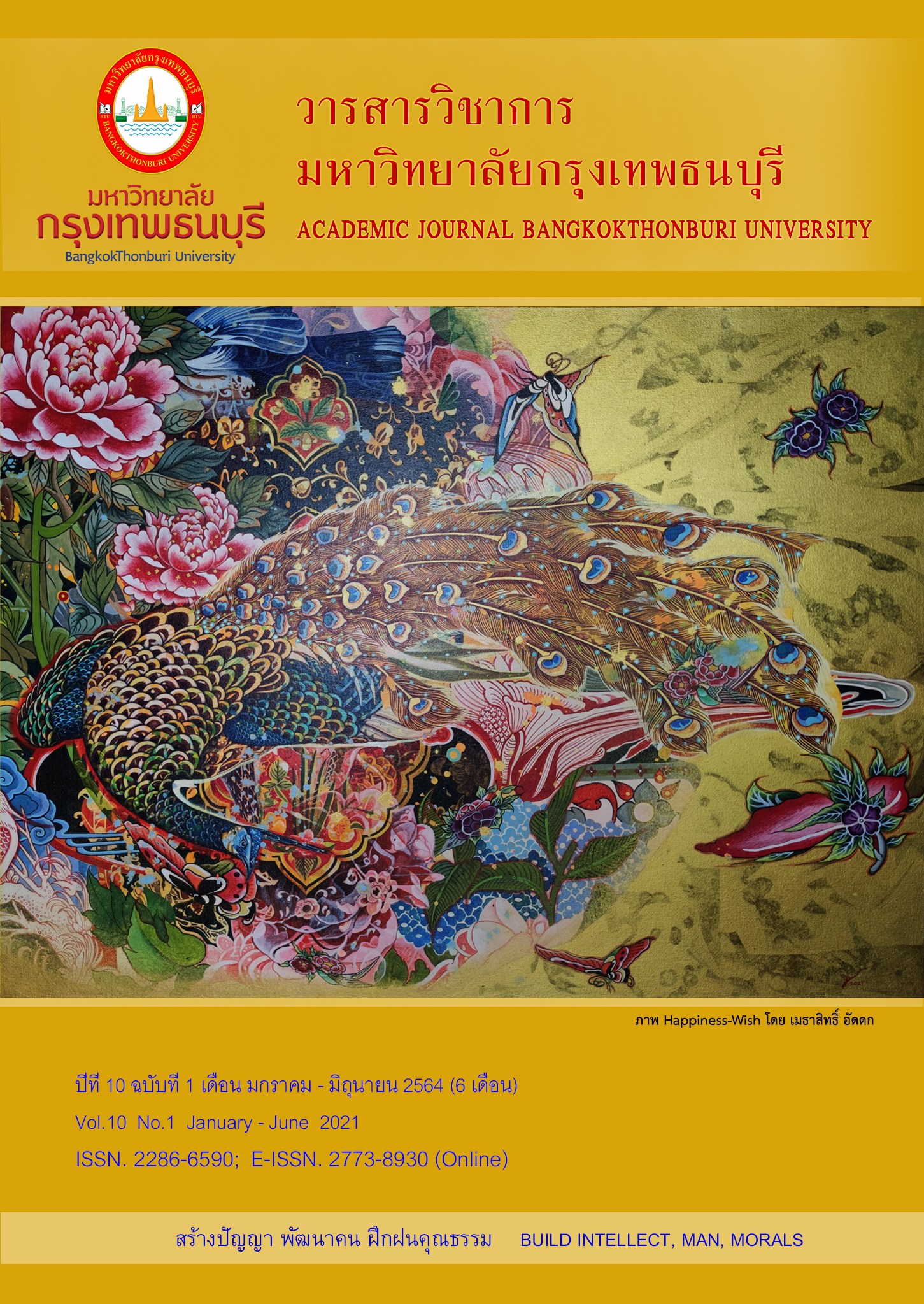ODI on Employee Motivation and Teamwork to Enhance Employee Performance: A Case Study of AAA Company Limited in a Pharmaceutical Industry (Based in Yangon, Myanmar)
Main Article Content
Abstract
Employees’ performance is one of the vital sources for organizations to remain healthy, prosperous and sustainable in this competitive world. The stronger the employees’ workforce, the better the organizations, hence, contributing greatly to national economic empowerment. The purpose of this study is to determine whether employees’ motivation and teamwork have an impact on employees’ performance as a whole through the organization development interventions. The focal system is a pharmaceutical company based in Yangon, Myanmar. Both quantitative and qualitative methods were used to test the hypotheses through surveys and questionnaires of both pre-ODI and post-ODI stages. The survey is designed to measure variables of employees’ motivation and teamwork. The action Research (AR) cycle of action planning, action taking and action evaluation, was engaged throughout the research process. In analyzing, describing the data set, pair t test, correlation, multiple linear regression was performed for quantitative analysis whereas content analysis was used for qualitative data analysis. The study has shown there is a very significant relationship between employees’ motivation and teamwork and employees’ performance. It is shown that ODIs were effective in increasing employees’ motivation and teamwork which lead to stronger employees’ performance. Recommendations to a focal company to sustain the positive changes. Finally, with the case of this company in Myanmar, the relevant and applicable comments for pharmaceutical companies are made as for the betterment of the industry.
Article Details
References
Rowden, R. W., & Conine, C. J. (2005). The impact of workplace learning on job satisfaction in small US commercial banks. Journal of Workplace Learning,, 215-230.
Access to Medicine Foundation. (2014, November 17). Access to Medicine Foundation. Retrieved from https://accesstomedicinefoundation.org/: https://accesstomedicinefoundation.org/newsroom/pharmaceutical-industry-doing-more-to-improve-access-to-medicine-in-developing-countries-performance-on-some-aspects-lags
Azar, M., & Shafighi, A. A. (2013). The Effect of Work Motivation on Employees‟ Job Performance (Case Study: Employees of Isfahan Islamic Revolution Housing Foundation), .
Bishop, J. (1987). The Recognition and Reward of Employee Performance. Journal of Labor Economics, .
Bjarnegård, E. (2020). Introduction: Development Challenges in Myanmar: Political Development and Politics of Development Intertwined. The European Journal of Development Research, 255–273. doi:https://doi.org/10.1057/s41287-020-00263-2
Blenko, D. (2017). Appreciative inquiry as a resource for positive change in a church ministry. Pepperdine Digital Commons,A Research Project. doi:https://digitalcommons.pepperdine.edu/etd/829
Chamberlain, P., & Rosicky, J. G. (1995). THE EFFECTIVENESS OF FAMILY THERAPY IN THE TREATMENT OF ADOLESCENTS WITH CONDUCT DISORDERS AND DELINQUENCY, The Career Development Quarterly, Vol.44.
Chen,Y, L. H. (2002). Towards an understanding of the behavioral intention to use a groupware application. . Journal of End User Computing, 1-16.
Chintalloo, S., & Mahadeo, C. (2013). Effect of Motivation on Employees‟ Work Performance at Ireland Blyth Limited:Proceedings of 8th Annual London Business Research Conference Imperial College, . London, UK,.
Cummings, T. G., & Worley, C. G. (2009). Organization Development and Change (9th ed.). Ohio: South-Western Cengage Learning. Retrieved from http://www.mcs.gov.kh/wp-content/uploads/2017/07/Organization-Development-and-Change.pdf
Grant, A. M. (2008). The significance of task significance: Job performance effects, relational mechanisms, and boundary conditions. Journal of Applied Psychology, 180-124.
Hackman, J. R. (2002). Leading teams: Setting the stage for great performances. Boston: Harvard Business School Press.
Hanaysha, J. (2016). Testing the Effect of Employee Empoerment, Teamwork, Employee Training on Employee Productivity in Higher Education Sector. Skyline University College.
Hayes, S. C. (2005). Eleven rules for a more successful clinical psychology. Journal of Clinical Psychology, 1055-1060.
Herzberg, F. (1959). The motivation to work.
Herztberg, F. (1966). Work and Nature of Man,. Word Publishing Company, Cleveland.
HR News, M. I. (2018, October 11). Employee motivation decline. Bridgend: Codel Software Ltd, http://hrnews.co.uk/employee-motivation-decline/. Retrieved from http://hrnews.co.uk/employee-motivation-decline/
Hunjra, ,. A., & Rehman, K. U. (2011). Factors Effecting Job Satisfaction of Employees in Pakistani Banking Sector,. African Journal of Business Management, Vol. 4, 2157-2163,.
Kabir, M. N., & Parvin, M. M. (2011). Factors affecting employee job satisfaction of pharmaceutical sector. Australian Journal of Business and Management Research, 112-123.
Kanelopoulos, C., & Akrivos, C. (2006). Career development in Greek management, . In Spoudai.
Katzenbach, J. R., & Smith, D. K. (1993). The Discipline of Teams, Harvard Business Review.
Kessler, E. H. (2013). Encyclopedia of Management Theory. New York City: Pace University.
Kreitner, R., & Kinicki, A. (2004). Organizational behavior. In M. M. Hill. Boston,.
Lewis, S. G., & Rapoport, R. R. (2007). The constraints of a work–life balance‟ approach: An international perspective. The International Journal of HumanResource Management.
Maslow, A. H. (1943). A Theory of Human Motivation. Psychological Review, Harper.
Meyer, J. O., & Allen, N. J. (2002). A three-component conceptualization of organizational commitment, Human Resource and Management Preview.
Mikulic, M. (2020, May 25). https://www.statista.com/. Retrieved from Statista: https://www.statista.com/statistics/263102/pharmaceutical-market-worldwide-revenue-since-2001/
Naneva, N. (2018). Marketing Strategies During the Product Life Cycle. Retrieved from ScholarWorks@waldenu.edu: https://scholarworks.waldenu.edu/cgi/viewcontent.cgi?article=7352&context=dissertations
OSEI BOAKYE, E. (2015). The impact of teamwork on employee performance. University of Ghana.
Panyashom, P., & Ye, Y. (2017). A Comparative Study of the Teachers’ Motivation According to their Demographics. Thailand: Bangkok Christian College.
Pharmaceutical Technology. (2016). Malaysian pharmaceutical market to grow at CAGR of 9.5% by 2020. Malaysia: Pharmaceutical Technology. Retrieved from https://www.pharmaceutical-technology.com/news/newsreport-malaysian-pharmaceutical-market-to-grow-at-a-cagr-of-95-by-2020-5018511/
Pharmacy Owner. (2016, June 30). Pharmacy Development Services. Retrieved from https://www.pharmacyowners.com/5-ways-to-build-a-high-performing-team
Scott, S. G., & Bruce, R. A. (1994). Determinants of Innovative Behavior: A Path Model of Individual Innovation in the Workplace,. The Academy of Management Journal,, 580-607.
Selfridge, R. J., & Sokolik, S. L. (1975). A comprehensive view of organizational development. MSU Business Topics.
Shahzadi et al., I. (2014). Impact of Employee Motivation on Employee Performance. European Journal of Business and Management, 159-167. Retrieved from https://iiste.org/Journals/index.php/EJBM/article/view/14794/15276
Tsai, J. E., & Uchida, Y. (2007). Learning What Feelings to Desire: Socialization of Ideal Affect Through Children's Storybooks,. In Personality and SocialPsychology Bullentin (pp. 17-30).
Widyastuti, T., & Hidayat, R. (2018). Adaptation of Individual Work Performance Questionnaire(IWPQ). International Journal of Research Studies in Psychology, VII(2), 101-112.
Yang, H. (2008). EfficiencyWagesandSubjectivePerformancePay‟. EconomicInquiry, 179-196.
Yazıcı, N. K. (2008). TheEffectOfRewardSystemApplicationsOnEmployeePerformanceInServiceSector. Marmara University, Institute of Social Sciences, Master Thesis.


